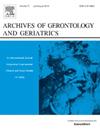在一个具有全国代表性的社区队列中,内在能力缺陷贯穿整个生命周期:来自皇后镇研究的发现
IF 3.8
3区 医学
Q2 GERIATRICS & GERONTOLOGY
引用次数: 0
摘要
内在能力(IC)是世界卫生组织健康老龄化的生命过程方法的核心。整个生命周期的人口数据仍然有限。本研究旨在评估新加坡具有全国代表性的社区队列中IC缺陷的患病率,并确定与这些缺陷相关的社会人口统计学、临床和生活方式因素。方法对Queenstown研究中年龄≥21岁的成年人进行横断面调查。使用改进的WHO ICOPE第1步筛查方法评估IC。收集了社会人口和健康数据。结果4274名受试者中,29.2%存在≥1个IC缺陷;随着年龄的增长,患病率从10.3%(20-39岁)逐渐上升到19.1%(40-59岁)、45.0%(60-79岁)和74.5%(≥80岁)。运动障碍(16.8%)和感觉障碍(11.4%)最为常见。在多变量分析中,IC赤字与老年有关(或每年1.05,95%可信区间1.04 - -1.06,p & lt; 0.001),女性性(或1.19,95%可信区间1.01 - -1.40,p = 0.037),体重不足(或1.61,95%可信区间1.18 - -2.20,p = 0.003),和肥胖(或1.36,95%可信区间1.07 - -1.71,p = 0.011),虚弱(或10.94,95%可信区间3.57 - -48.14,p & lt; 0.001),仪器ADLs受损(或3.93,95%可信区间2.11 - -7.84,p & lt; 0.001),低握力(或1.68,95%可信区间1.43 - -1.97,p & lt; 0.001)、糖尿病(或1.45,95% CI 1.12-1.87, p = 0.004)和社会孤立(OR 1.23, 95% CI 1.04-1.45, p = 0.014)。较高的生活质量具有保护作用(OR 0.84, 95% CI 0.80-0.89, p < 0.001)。结论:即使在中年人中,视力缺陷也很普遍,并与可改变的因素有关。这些发现支持早期多领域干预的必要性,以保持功能并促进整个成年期的健康老龄化。本文章由计算机程序翻译,如有差异,请以英文原文为准。
Intrinsic capacity deficits across the lifespan in a nationally representative community cohort: findings from the Queenstown study
Background
Intrinsic capacity (IC) is central to the World Health Organization’s life course approach to healthy ageing. Population-level data across the lifespan remain limited. This study aimed to assess the prevalence of IC deficits and to identify sociodemographic, clinical, and lifestyle factors associated with these deficits in a nationally representative community cohort in Singapore.
Methods
Cross-sectional survey of adults aged ≥21 years in the Queenstown Study. IC was assessed using a modified WHO ICOPE Step 1 screening approach. Sociodemographic and health data were collected.
Results
Among 4274 participants, 29.2 % had ≥1 IC deficit; prevalence rose stepwise with age from 10.3 % (20–39 years) to 19.1 % (40–59), 45.0 % (60–79) and 74.5 % (≥80 years). Locomotion (16.8 %) and sensory (11.4 %) deficits were most common. In multivariable analysis, IC deficits were associated with older age (OR 1.05 per year, 95 % CI 1.04–1.06, p < 0.001), female sex (OR 1.19, 95 % CI 1.01–1.40, p = 0.037), underweight (OR 1.61, 95 % CI 1.18–2.20, p = 0.003), and obesity (OR 1.36, 95 % CI 1.07–1.71, p = 0.011), frailty (OR 10.94, 95 % CI 3.57–48.14, p < 0.001), impaired instrumental ADLs (OR 3.93, 95 % CI 2.11–7.84, p < 0.001), low handgrip strength (OR 1.68, 95 % CI 1.43–1.97, p < 0.001), diabetes (OR 1.45, 95 % CI 1.12–1.87, p = 0.004), and social isolation (OR 1.23, 95 % CI 1.04–1.45, p = 0.014). Higher quality of life was protective (OR 0.84, 95 % CI 0.80–0.89, p < 0.001).
Conclusion
IC deficits were prevalent even in midlife and linked to modifiable factors. These findings support the need for early, multidomain interventions to preserve function and promote healthy ageing across adulthood.
求助全文
通过发布文献求助,成功后即可免费获取论文全文。
去求助
来源期刊
CiteScore
7.30
自引率
5.00%
发文量
198
审稿时长
16 days
期刊介绍:
Archives of Gerontology and Geriatrics provides a medium for the publication of papers from the fields of experimental gerontology and clinical and social geriatrics. The principal aim of the journal is to facilitate the exchange of information between specialists in these three fields of gerontological research. Experimental papers dealing with the basic mechanisms of aging at molecular, cellular, tissue or organ levels will be published.
Clinical papers will be accepted if they provide sufficiently new information or are of fundamental importance for the knowledge of human aging. Purely descriptive clinical papers will be accepted only if the results permit further interpretation. Papers dealing with anti-aging pharmacological preparations in humans are welcome. Papers on the social aspects of geriatrics will be accepted if they are of general interest regarding the epidemiology of aging and the efficiency and working methods of the social organizations for the health care of the elderly.

 求助内容:
求助内容: 应助结果提醒方式:
应助结果提醒方式:


